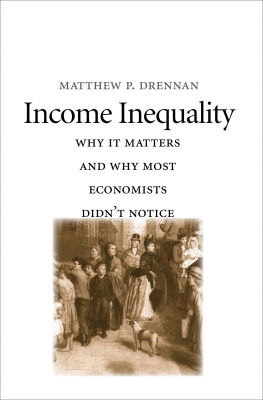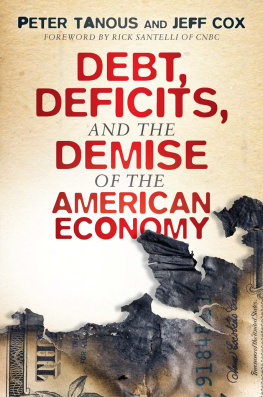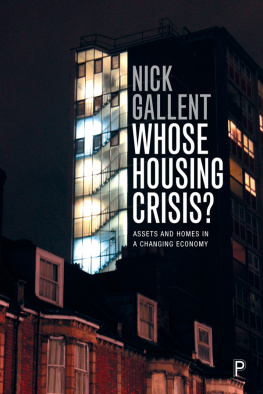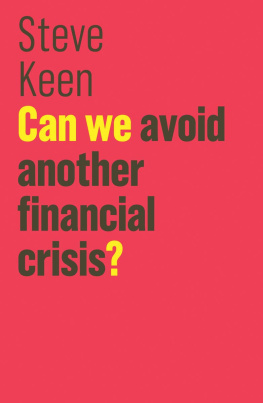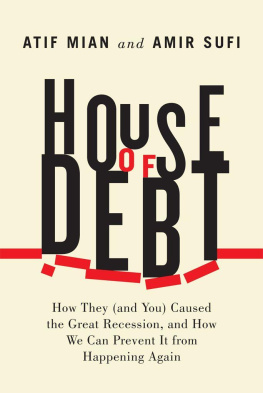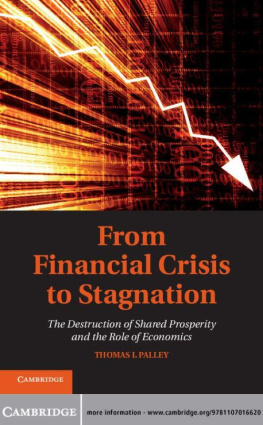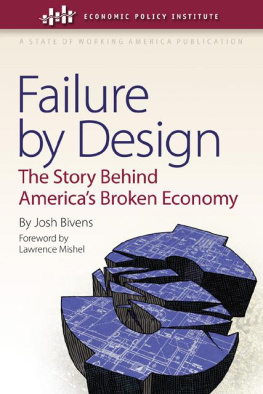Income Inequality
Income Inequality
Why It Matters and Why Most Economists Didnt Notice
MATTHEW P. DRENNAN

Copyright 2015 by Matthew P. Drennan.
All rights reserved.
This book may not be reproduced, in whole or in part, including illustrations, in any form (beyond that copying permitted by Sections 107 and 108 of the U.S. Copyright Law and except by reviewers for the public press), without written permission from the publishers.
Yale University Press books may be purchased in quantity for educational, business, or promotional use. For information, please e-mail (U.K. office).
Set in Minion type by Integrated Publishing Solutions.
Printed in the United States of America.
Library of Congress Control Number: 2015940164
ISBN 978-0-300-20958-7 (cloth : alk. paper)
A catalogue record for this book is available from the British Library.
This paper meets the requirements of ANSI/NISO Z39.48-1992
(Permanence of Paper).
10 9 8 7 6 5 4 3 2 1
To my wife, Katherine Van Wezel Stone,
My children, Matthew, Maureen, and Erica,
And my grandchildren, Grace and Ava Drennan
Contents
Acknowledgments
This work has been more than four years in the making. It began as an insight in early 2009, in the wake of the initial shock of the financial crash, when I realized that the dramatically rising income inequality of the past three decades might have played a role. The more I explored the data and the debates about causes of the crash and ensuing Great Recession, the more convinced I became that the conventional economic explanations were missing a critical piece of the puzzle. I realized then that it was necessary not only to put income inequality back into the story but also to explain why that part of the story had not been told already. That is, I wanted to understand why economists had failed to see the significance of the most important economic trend of the past three decadesthe dramatic rise in inequality.
Many institutions and people have assisted in this work. The Russell Sage Foundation generously financed the first phase of this study. In addition, Cornell Universitys Podell Emeriti Award for Research and Scholarship provided subsequent funding for research expenses. From the beginning of this project, the Luskin Schools Department of Urban Planning at the University of California, Los Angeles, provided the library resources, an office, IT assistance, and most importantly, colleagues, which are so necessary for academic research. For the semester that I spent in New York City, I was generously provided with an office at the New York University Schack Institute of Real Estate by the dean, Rosemary Scanlon, and a professor there, Hugh Kelly.
UCLAs statistical consulting group at the Institute for Digital Research and Education gave me invaluable assistance at every step. I sent them countless email queries that they answered in a day or lessright answers, too. I made many trips to their walk-in consulting sessions, trips that were always worthwhile.
I had the good fortune of having a number of astute, supportive, yet critical readers. I particularly want to thank Alan Altshuler, Charles Brecher, Robert Hockett, Raymond Horton, Morton Horwitz, Christopher Jencks, and David Rigby for pushing me to sharpen my arguments and sharing with me important literature. I also want to thank participants in the Brown Bag Lunch speaker series at the New York Federal Reserve Bank, where I made an invited presentation on this project in the fall of 2012. Among the participants, Erica Groshen, Andrew Haughwout, and James Orr offered cogent remarks, and they pointed me to important data sources. Two anonymous referees deserve thanks for suggestions that markedly improved this manuscript.
I have had the great benefit of the services of several talented graduate students at UCLA. The spare simplicity and clarity of the tables and figures I attribute to two excellent research assistants at UCLA: Anne Brown and Taner Osman. They both know that the sole purpose of tables and figures is to elucidate the argument, not to drown it in obscurity. Of the nineteen tables, Anne produced sixteen of them, and I did the other three (Tables , is taken from an International Monetary Fund (IMF) paper with permission. Anne Brown has been a critical assistant in the final preparation of the manuscript to Yales exacting standards. Mike Manville, a former Ph.D. student in urban planning at UCLA (now an assistant professor at Cornell), read every word of various drafts in the early stage of producing this book. He made both substantive and technical suggestions that I mostly accepted.
I wish to acknowledge my editors at Yale University Press, William Frucht and Jaya Chatterjee, who have made this book production process exciting rather than tedious. My copy editor, Joyce Ippolito, and my production editor, Ann-Marie Imbornoni, purged the manuscript and proofs of numerous flaws I had overlooked, and they did that with speed and grace. Their standards of excellence and respectful treatment would flatter any author.
Most of all I thank my wife, Katherine Stone, who encouraged me in pursuing this project from the beginning and discussed the ideas in depth. She also read every word more than once, and her suggestions have enhanced the final manuscript. She has been an invaluable asset for my project, always eager to help and always giving excellent suggestions.
I Introduction
This book tells two stories. The first tells how rising income inequality over the past decades led to rising, indeed surging, household debt to support consumption, a surge that brought on the financial crisis and Great Recession of 200809. The second shows that mainstream economists have adhered to a theory of consumption that assigns no role to the distribution of income, and therefore is inadequate for fully understanding the Great Recession or preventing the next one.
Of course rising income inequality is only one of the causes of the surge in household debt, but it is an important one that is too often neglected by economists and policy makers. The period from about 1995 to 2007, especially post 2000, can be characterized as a perfect firestorm of household indebtedness, fueled by four factors: (1) stagnant incomes for most households related to the long-term rise in income inequality; (2) unusually low interest rates after 2000; (3) legal and institutional changes that relaxed borrowing standards of lenders, raised the availability of credit, and made housing a more liquid asset; and (4) the housing price bubble. The bursting of that bubble in 200607 precipitated the financial crisis and the Great Recession, but it was only the last straw. The debt-supported expansion of consumption became unsustainable after 2007. Because consumers have begun to reduce their debtdeleveragingand increase their saving, consumption will be depressed for some years, producing an anemic recovery.
Most analyses of the financial crash and Great Recession identify factors (2) through (4) as causes but not (1), income inequality. Some, such as Till van Treeck, identify (1), rising income inequality, as well.
There is substantial evidence that the rising inter-household inequality in the United States has importantly contributed to the fall in the personal saving rate and the rise in personal debt (and a higher labour supply). Aided by the easy availability of credit, lower and middle income households attempted to keep up with the higher consumption levels of top income households. This has contributed to the emergence of a credit bubble which eventually burst and triggered the Great Recession.
Next page
